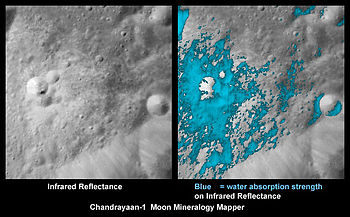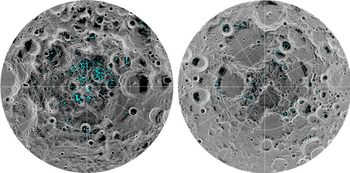
Back ماء قمري Arabic Лёд на Месяцы Byelorussian चंद्रमा पर पानी Bihari চান্দ্রজল Bengali/Bangla Aigua a la Lluna Catalan Voda na Měsíci Czech Månens is Danish Agua lunar Spanish آب در ماه Persian Eau sur la Lune French


The search for the presence of lunar water has attracted considerable attention and motivated several recent lunar missions, largely because of water's usefulness in making long-term lunar habitation feasible.[1]
The Moon is believed to be generally anhydrous after analysis of Apollo mission soil samples. It is understood that any water vapor on the surface would generally be decomposed by sunlight, leaving hydrogen and oxygen lost to outer space. However, subsequent robotic probes found evidence of water, especially of water ice in some permanently-shadowed craters on the Moon; and in 2018 water ice was confirmed in multiple locations.[2][3][4][5] This water ice is not in the form of sheets of ice on the surface nor just under the surface, but there may be small (less than about 10 centimetres (3.9 in)) chunks of ice mixed into the regolith, and some water is chemically bonded with minerals.[6][7][8] Other experiments have detected water molecules in the negligible lunar atmosphere,[9] and even some in low concentrations at the Moon's sunlit surface.[10]
On the Moon, water (H2O) and hydroxyl group (-OH) are not present as free water but are chemically bonded within minerals as hydrates and hydroxides, existing in low concentrations across the lunar surface.[11][12] Adsorbed water is estimated to be traceable at levels of 10 to 1000 ppm.[13] The presence of water may be attributed to two primary sources: delivery over geological timescales via impacts and in situ production through interactions of solar wind hydrogen ions with oxygen-bearing minerals.[14][15] Confirmed hydroxyl-bearing materials include glasses, apatite [Ca5(PO4)3(F, Cl, OH)], and novograblenovite [(NH4)MgCl3·6H2O].
NASA's Ice-Mining Experiment-1 (set to launch on the PRIME-1 mission no earlier than late 2024) is intended to answer whether or not water ice is present in usable quantities in the southern polar region.[16]
- ^ "The Moon". nssdc.gsfc.nasa.gov. Retrieved 2022-07-07.
- ^ Water and Ices on the Moon", science.nasa.gov, fetched 11 June 2024
- ^ "Ice Confirmed at the Moon's Poles". NASA Jet Propulsion Laboratory (JPL). Retrieved 2023-04-13.
- ^ Water on the Moon: Direct evidence from Chandrayaan-1's Moon Impact Probe. Published on 2010/04/07.
- ^ Pinson, Jerald (2020-11-20). "Moon May Hold Billions of Tons of Subterranean Ice at Its Poles". Eos. 101. doi:10.1029/2020eo151889.
- ^ Akhmanova, M; Dement'ev, B; Markov, M (February 1978). "Water in the regolith of Mare Crisium (Luna-24)?". Geokhimiya (in Russian) (285).
- ^ Akhmanova, M; Dement'ev, B; Markov, M (1978). "Possible Water in Luna 24 Regolith from the Sea of Crises". Geochemistry International. 15 (166).
- ^ Pieters, C. M.; Goswami, J. N.; Clark, R. N.; Annadurai, M.; Boardman, J.; Buratti, B.; Combe, J. -P.; Dyar, M. D.; Green, R.; Head, J. W.; Hibbitts, C.; Hicks, M.; Isaacson, P.; Klima, R.; Kramer, G.; Kumar, S.; Livo, E.; Lundeen, S.; Malaret, E.; McCord, T.; Mustard, J.; Nettles, J.; Petro, N.; Runyon, C.; Staid, M.; Sunshine, J.; Taylor, L. A.; Tompkins, S.; Varanasi, P. (2009). "Character and Spatial Distribution of OH/H2O on the Surface of the Moon Seen by M3 on Chandrayaan-1". Science. 326 (5952): 568–572. Bibcode:2009Sci...326..568P. doi:10.1126/science.1178658. PMID 19779151.
- ^ "Is There an Atmosphere on the Moon? | NASA". nasa.gov. 7 June 2013. Retrieved 2015-05-25.
- ^ "NASA - SOFIA discovers water on sunlit surface of the Moon". NASA. 26 October 2020.
- ^ Lucey, Paul G. (23 October 2009). "A Lunar Waterworld". Science. 326 (5952): 531–532. Bibcode:2009Sci...326..531L. doi:10.1126/science.1181471. PMID 19779147.
- ^ "NASA's SOFIA Discovers Water on Sunlit Surface of Moon". NASA. 26 October 2020. Retrieved 26 October 2020.
- ^ Clark, Roger N. (23 October 2009). "Detection of Adsorbed Water and Hydroxyl on the Moon". Science. 326 (5952): 562–564. Bibcode:2009Sci...326..562C. doi:10.1126/science.1178105. PMID 19779152.
- ^ Elston, D.P. (1968) "Character and Geologic Habitat of Potential Deposits of Water, Carbon and Rare Gases on the Moon", Geological Problems in Lunar and Planetary Research, Proceedings of AAS/IAP Symposium, AAS Science and Technology Series, Supplement to Advances in the Astronautical Sciences., p. 441
- ^ "NASA – Lunar Prospector". lunar.arc.nasa.gov. Archived from the original on 2016-09-14. Retrieved 2015-05-25.
- ^ "NASA - NSSDCA - Spacecraft - Details".